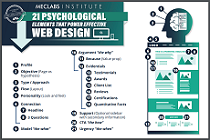March 20, 2001
Article
|
SUMMARY:
No summary available
|
|
***************
B2BMarketingBiz From MarketingSherpa.com
*************** March 20, 2001; Vol. 2, Issue 12
Please forward WITHOUT cutting.
Free subscriptions at: http://www.b2bmarketingbiz.com
1) News: Selling with Auto Email Campaigns; Renewing Your Domain
Name
2) Case Study: BMC Software Gets 50% Click Throughs From Fortune
500 Execs Via Non-Branded, Strictly Educational Sites
3) Practical Know-How: Eight Key Tactics to Create a Successful RFP
for a Your CRM/eCRM Data Integration Project
NOTE: Will you be at B-to-B BQ in Austin later this week? If you see a
six-foot tall redhead racing by, stop her and introduce yourself --
she's our publisher Anne Holland, and she's looking forward to
meeting you in person.
**********
NEWS
**********
Sponsor: iMakeNews.com
~~~~~~~~~~~~~~~~~~~~~~~~~~~~~~~~~~~~~~~~~~~~~~~~~~~~~~~~~~~~~~~~~~
MARKETERS:
Don't let your e-marketing efforts go to waste.
Don't let hard earned Web site visitors disappear without a trace.
Get a FREE opt-in list builder for your Web site
and start capturing and converting prospects to customers today.
http://www.imakenews.com/jump/affiliate.cfm?a_id=sherp_b2b1
Sign up now and send your first 1,000 emails FREE.
~~~~~~~~~~~~~~~~~~~~~~~~~~~~~~~~~~~~~~~~~~~~~~~~~~~~~~~~~~~~~~~~~~~
* Resell Accounts With Event-Driven Automatic Email Messages
Marketers selling products with set lifetimes should consider
adding event-driven email messages to their media mix. Ruth
Stevens, President of eMarketing Strategy and past Chair of the
DMA's B-to-B Council says these types of campaigns are known by a
variety of names including triggered email, lights-out email or
event-driven email.
Stevens says, "The email is set up to be automatically delivered at
a point when something happens to the account. It's triggered on a
one-to-one basis according to the mailer and the recipient." Her
favorite example: an email sent when accounts' warranties are about
to expire that asks 'Don't you want an extension?'
http://home.att.net/~ruth.stevens/
* Watch Out! Your Domain Name May Expire Soon
Do you know when your company's domain name registration expires?
It could be sooner than you think. In fact, when we looked up the
expiration dates for a few well-known B-to-B sites, we found that
according to public Internic records IBM's expires today, March 20th. If you
have a trademarked name, then you might not be in trouble because legal
precedents will stop squatters from claiming ownership. However, if your
domain name is not a trademarked name, if other organizations share it,
then watch out! Some people may be eagerly waiting for your domain
registration to lapse.
The problem for most marketers is that a couple of years ago when
many companies first registered their domains, it was usually the
webmaster or IT department's job to do so. By now chances are that
tech person may not even be at your company anymore. So domain
renewal notices emailed and mailed to his or her attention may
reach no one at all.
Your action items: go to a domain registration site such as Network
Solutions or NameSecure.com and type in your domain including the
".com" (or other ending.) Click on the link to "Who Is" to find
out who your company's official contacts are and when your domain's
registration expires. You may want to change the email address and
possibly the contact name to a mailbox that is guaranteed to always
be there -- such as "info@." You may also want to renew your
registration as far out as possible. (In fact many sites offer
substantial discounts to renew domains for ten-year periods.)
***********
CASE STUDY: BMC Software Gets 50% Click Throughs From Fortune 500
Execs Via Non-Branded, Strictly Educational Sites
************
Sponsored By: RedHerring.com
~~~~~~~~~~~~~~~~~~~~~~~~~~~~~~~~~~~~~~~~~~~~~~~~~~~~~~~~~~~
AFFORDABLE RATES AND GREAT DEMOGRAPHICS...
Who says the next big thing in advertising has to be hard to
find? Sponsor HERRINGTOWN, Red Herring's database of 5,000+
hot start-ups and 2,500 VCs, and connect with users who have
money (plenty of it) and are looking to spend and invest.
Write advertising@redherring.com or visit our media kit to
land the big one. http://www.redherringmedia.com/biz
~~~~~~~~~~~~~~~~~~~~~~~~~~~~~~~~~~~~~~~~~~~~~~~~~~~~~~~~~~~
CHALLENGE
BMC Software, the fifth largest software company in the
world, does business with about 90% of the Fortune 500. BMC had a
challenge common to high tech companies marketing online: their
prospects are not individuals, but rather committees composed of a
wide range of job-functions from IT to high-level strategy to
marketing. In addition, often some members of these committees
need educating in the broad technology landscape before they are
qualified to decide on BMC's product particulars.
Faced with this dilemma, many B-to-B marketers would put out a series
of white papers, plant some articles in trade publications, and
hope for the best. BMC decided to get aggressive and take
marketplace education one step further.
CAMPAIGN
Rather than using freelancers or asking marketing people
to create editorial content, BMC hired Christian Sarkar, a full-
time Editor in Chief with a strong tech magazine background.
Sarkar immediately made a critical strategic decision -- instead of
adding editorial content to BMC's corporate site, he decided to
separate it completely from marketing communications content by
creating all-new sites which weren't obviously branded by BMC. He
says, "Even if content on your corporate site is unbiased, it
automatically appears biased and less valuable. The perception of
virtue is almost as important as virtue itself."
Sarkar also recognized that the various members of a typical
Fortune 500 committee have very different educational needs and
content interests. Rather than creating one mega-site for them
all, he opted to create a series of completely separately branded
sites, each targeted to a specific type of professional. He says,
"It's better to have 1,500 people interested in one topic rather
than 200,000 people just bouncing around who aren't really
interested."
Each site includes content updated monthly, plus a strong community
section where members can discuss hot topics with each other on
bulletin boards. The sites include:
QualityofExperience.org -- targeting the CXO level (CEO, CFO, etc.)
and "ebusiness process owners"
AgileBrain.com -- targeting marketers and mid-level ebusiness
directors with a "very non-tech" background.
NextSLM.org -- targeting executives interested in sophisticated
service level management.
DBAzine -- targeting techies who are deeply interested in database
issues.
Sarkar drove site traffic by issuing press releases; soliciting
content from famous name-brand "gurus"; sponsoring email discussion
groups on related sites; and through a short-term online marketing
campaign created by Target Market Interactive in LA which included
email newsletter sponsorships and banners on other sites.
BMC's presence on its sites is minimal. You'll see no BMC banners
or big flashy ads. Instead you'll see a small, black and white
"Sponsored by" line. Sarkar says, "We're not actively selling."
In fact, only two of the sites include active offers to drive
traffic to BMC's corporate site. Both NextSLM and
QualityofExperience offer links within related articles to free
site assessement tools at BMC.com
Sarkar notes that the church and state separation between the
editorial sites and corporate is as strict as possible. He says,
"We've separated the selling from the learning. None of the people
who register for the sites go into the BMC database. Their privacy
is respected. Our sales guys can't sell them a product without
them going to BMC.com. There's a clear line when you move to
BMC.com. They have a different privacy policy. We warn them
beforehand."
RESULTS
A stunning 50% of editorial site members go check out
BMC's corporate site eventually simply out of curiosity. 85% of
visitors who saw the editorial article about BMC's free assessment
tool clicked over to the corporate site to take advantage of it.
Sarkar notes, "We have a 5-6% return from the link that just says,
'Sponsored by BMC.' That's amazing!"
Each of the sites has been successful at attracting thousands of
highly targeted executives. Sarkar says the most effective methods
have been word of mouth and search engine optimization. Posting
articles from famous-name gurus help on both counts. He's also
discovered partnerships can make press releases more effective, "If
you do a press release saying 'AgileBrain says' that's great; but,
if you say, 'Price Waterhouse Coopers, Seybold, Sun and AgileBrain
say' more reporters will pick it up, more people will read it and
get back to us. Automatically we've created a bigger net."
Once targeted traffic arrives at these sites, it sticks around.
Average visitor lengths range from 12 minutes for AgileBrains to 44
minutes on DBAzine.
Yes, Sarkar plans to launch more niche sites for BMC in the future!
NOTE: Sarkar feels strongly that to be successful, "high level"
B2B Web sites must contain easy-to-navigate useful information. He
says, "Marketing people just think it's all about Flash or looking
good but your online brand is the experience online. It's not
enough to have a fancy Web site that does stuff. You can't drop
the ball anywhere."
http://www.qualityofexperience.org
http://www.agilebrain.com
http://www.nextslm.org
http://www.dbazine.com
http://www.bmc.com
http://www.tmi-la.com
*******************
PRACTICAL KNOW-HOW: Eight Key Tactics to Create a Successful RFP
for a Your CRM/eCRM Data Integration Project
*******************
Sponsor: Touchscape
~~~~~ 57 Things to Know About Your Customers ~~~~~~~~~~~~~~~~~~
Learn these 57 things every marketing professional needs to
keep customers coming back! Get these tips and more with
insite, a free publication from TouchScape. TouchScape
provides Web-hosted software that connects companies to their
customers by adding e-mail marketing, online registration,
and customer service to their Websites. To receive your copy
of insite or demo of TouchScape's exciting new Website
applications, visit:
http://www.touchscape.com/b2b or call 1-888-488-2664.
~~~~~~~~~~~~~~~~~~~~~~~~~~~~~~~~~~~~~~~~~~~~~~~~~~~~~~~~~~~~~~~~~
These days it seems like every B-to-B marketer on this planet is
working on an integration project. Integrating offline and online
customer and prospect data, integrating online and offline campaign
results, integrating the campaigns themselves ... you name it.
Which is why we're hearing so much about CRM and eCRM, buzzword
terms whose meanings have broadened almost beyond usefulness.
Bernice Grossman, President DMRS Group, has been advising B-to-B
marketers on their database marketing, integrated systems, and CRM
projects since 1983. So, she's lead a heck of a lot of companies
through the process of finding just the right technology vendors
for their integration needs. We contacted her to get useful
tactics for the very first step in any integration project --
gathering needs assessment data and creating an RFP.
BEST QUOTE: "The absolute guaranteed way for a user to request a
report is to draw what they expect to get back. Anyone with
technical comprehension will look at it and say, 'Oh yeah, I can do
that' or 'I can do this, that's close, how about it?' You draw a
picture with a pencil and everybody's level of expectation is
equal."
1. Start by Speaking in English
No you don't have to rush out and learn all about the latest
technology or start flinging around buzzwords with joyful abandon.
In fact, Grossman says your very first step should be speaking
about your needs and making all basic decisions in clear, standard
English that any non-techie can understand.
2. Examine Your Needs First -- Not the Technology
It's easy to get swept up by information on hot new technologies
and vendors; however, your starting point for the RFP process
should be your own company's needs. Grossman says you must be able
to detail the following basics before beginning to examine
solutions:
- What you really want the solution to solve and/or do
- How you expect it will solve or do it
- How it will interface with all the various users in your
organization, including different departments
- How (if at all) customers and prospects will interface with it
3. Why Hire an Outside Consultant
Consultants are often brought in as a solution to internal politics
that might stymie a cross-departmental committee. Grossman also
notes that consultants bring a distanced, objective viewpoint, and
"sometimes as a user you're too close to objectively define what
you need."
Plus, gathering data and company-wide agreement for an RFP is an
enormously time-consuming task. Most executives are already too
busy with their own schedules to give it the focused attention it
demands.
4. How to Pick the Right Consultant
Contact the Direct Marketing Association (DMA) for their roster of
members who are consultants in this area. When selecting the
consultants, check their references carefully by personally talking
to a point person at the other companies they've worked for.
Aside from technical competency, the most critical thing you should
look for is a cultural match. Grossman says, "Some of these
meetings are long, detailed and boring. If you're not comfortable
with the personality of the consultant, it's really going to be
painful, or unpleasant, or not as productive as you would hope."
Are consultants from big brand name organizations necessarily
better than others? Again it comes down to culture. If these are
the only kinds of companies you tend to use for other purposes,
they may be the most comfortable for you to work with on this
project. However, make sure you'll be working with specific
individuals with an expertise in database management and CRM,
rather than management consulting generalists.
5. How to Keep Your IT Department Happy
Make absolutely sure you have complete agreement from your IT
department, about both the need for the project and the exact
consultant who will be hired to lead it, BEFORE you bring a
consultant in. Many IT departments feel very uncomfortable with
consultants that other, less technical, departments hire.
Grossman warns, "Do not do this unless you have buy-in from IT. If
you have a consultant who's willing to do without it, don't hire
them!"
One way to allay IT's concerns with the entire project is to make
it clear that your initial ideas are not fixed in concrete; and
that both you and the consultant are totally open at a variety of
solutions including IT themselves taking a senior advisory role or
taking the end-project entirely in-house if it makes sense. (BTW:
This is one good reason not to hire a consultancy that already has
a built-in business partnership with another technology company,
because your IT may not trust the consultant to look beyond that
relationship for the best possible solution.)
6. What Other Departments Should Be Involved
While you don't want a task force of 25 people because it would be
hard to get meetings scheduled, much less get anything done in
them, you definitely need to invite serious contributions from a
wide variety of departments, including:
- marketing
- sales
- investor relations/corporate communications
- customer service
- your whole "e-group"
- operations
- fulfillment
- the call center
- finance and legal
- outside service bureaus and service providers
- outside marketing, advertising and PR firms
Every single one of these groups has some type of data that should
be considered, and they'll all expect to touch the data that comes
out of the new integrated system in some way. Now is the time to
get all these expectations voiced.
7. How Long the Needs Assessment Process Should Take
Longer than you may think. In fact it takes many companies about
three months even with the help of an experienced consultant.
Reality is that meetings are hard to schedule, holidays and
weekends intrude, your people go on vacation, snowstorms happen,
etc. Grossman has completed some projects in about half that time
if "you're a really together client." She also notes that smaller,
limited scope projects take less time.
One other thing to remember -- there aren't loads of experienced
consultants in this field and these days everybody's trying to hire
them. You may have to wait in line for a bit.
8. What Makes a Useful RFP (vs. a Lousy One)
One simple thing makes the difference between a good and a bad RFP.
Bad RFPs provide a check-off column where potential vendors can say
whether they comply or not. Grossman says, "It's useless. It
doesn't mean anything!" She compares a check off box to asking
someone, 'Do you dance?' If they say 'Yes' how much do you really
know about their ability?
Instead, you should ask that vendors provide either a software
screenshot or a very detailed explanation to support every single
answer they give, so you are sure they really can provide the tech
you require. Responses can't just be positive they must show
proof. The place to request that explicit proof is in your RFP ...
long before you take your first vendor pitch meeting.
Coming in two issues: Grossman on what comes after the RFP.
http://www.dmrsgroup.com
**************************************************************
B2BMARKETINGBIZ.COM INFO
**************************************************************
To subscribe (FREE!) or unsubscribe (EASY!):
Use the box on our Web site
http://www.B2BMarketingBiz.com
Reach 10,000+ B-to-B Marketers Every Week! Free Media Kit:
ads@marketingsherpa.com
Editorial Contact:
editor@B2BMarketingBiz.com
Publisher:
Anne Holland
anneh@MarketingSherpa.com
202.232.6830
(c) Copyright 2001, MarketingSherpa, Inc.









